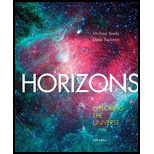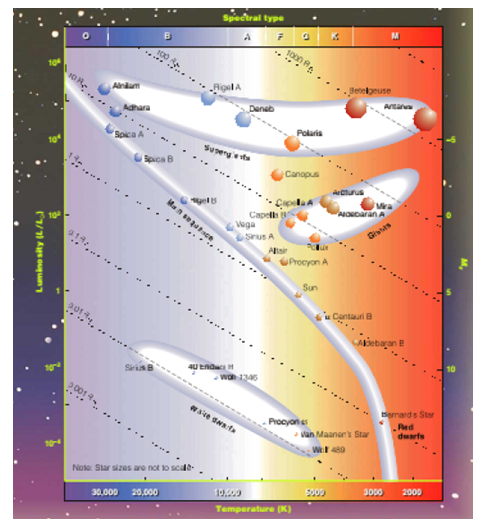
Concept explainers
- Which star is brightest?
- Which star is most luminous in absolute magnitude?
- Which star is largest?
- Which star is farthest away?
Answer to Problem 10P
- The brightest star is a.
- The most luminous star in absolute magnitude is c.
- The largest star is c.
- The farthest away star is d.
Explanation of Solution
Given:
Table
| Star | Spectral type | |
| a | G2 V | 5 |
| b | B1 V | 8 |
| c | G2 Ib | 10 |
| d | M5 III | 19 |
| e | White dwarf | 15 |
Formula used:
Absolute magnitude of the star is given as

Calculation:
Consider the H-R diagram

Figure.1
(a)
The classification of the star is G2 V, here G suggests that class of the star, and V suggest that it is a main sequence star. By the help of this we can estimate the absolute magnitude of the star using H-R diagram
It is clear from the figure that the absolute magnitude of the star is 5
Apparent magnitude of the star is give as
Plugging the values in the above equation
(b)
The classification of the star is B1 V, here B suggests that class of the star, and V suggest that it is a main sequence star. By the help of this we can estimate the absolute magnitude of the star using H-R diagram
It is clear from the figure that the absolute magnitude of the star is -1
Apparent magnitude of the star is give as
Plugging the values in the above equation
(c)
The classification of the star is G2 Ib, here G suggests that class of the star, and Ib suggest that it is supergiant star. By the help of this we can estimate the absolute magnitude of the star using H-R diagram
It is clear from the figure that the absolute magnitude of the star is -7
Apparent magnitude of the star is give as
Plugging the values in the above equation
(d)
The classification of the star is M5 III, here G suggests that class of the star, and III suggest that it is giant star. By the help of this we can estimate the absolute magnitude of the star using H-R diagram
It is clear from the figure that the absolute magnitude of the star is 0
Apparent magnitude of the star is give as
Plugging the values in the above equation
(e)
The absolute magnitude of the white dwarf is always greater or equal to 10.
Apparent magnitude of the star is give as
Plugging the values in the above equation
Thus, it is clear that, brightest star in apparent magnitude is a, most luminous absolute magnitude star is c, largest star is c because it is a supergiant star, and farthest away star is d.
Conclusion:
- The brightest star is a.
- The most luminous star in absolute magnitude is c.
- The largest star is c.
- The farthest away star is d.
Want to see more full solutions like this?
Chapter 8 Solutions
Horizons: Exploring the Universe (MindTap Course List)
- Is the Sun an average star? Why or why not?arrow_forwardDescribe two ways of determining the diameter of a star.arrow_forwardWhich of the following WOULD NOT characterizes the type(s) of star we would find at g, m, n, o, and p on the Hertzsprung-Russel Diagram (Figure 4) a. are all smaller than q,i,h. b. fuse hydrogen into helium. c. are called, “the main sequence”. d. fuse He into heavier elements. e. get smaller towards the right sidearrow_forward
- Which of the following is largest? the size of a typical star. 1 AU. the size of the earth. 1 light-minute.arrow_forwardConsider two stars with mV = 2.2 and mV = −1.5. What is their combined visual magnitude? Commenton whether your answer is plausible.arrow_forwardPlease answer them:) Hey! As you can see, there is an image wherein the question is cut of. Here is the question: Which of the following statements is CORRECT in terms of the star's absolute magnitude??arrow_forward
- In your own words, describe the difference between apparent magnitude and absolute magnitude. Explain the relationship between apparent magnitude, absolute magnitude and distance.arrow_forwardConsider two identical stars, A and B. Star B is 10 times farther away than star A. What is the difference in magnitudes between the two stars?arrow_forwardUse a diagram to explain what is meant by the parallax angle, p, for a star observed twice from Earth, with a 6-month interval between each observation. Hence define the parsec, and calculate its value in astronomical units and metres. The star Betelgeuse is observed to have a parallax angle p = 4.5 × 10−3 arcseconds. State the distance of Betelgeuse in units of parsecs and light years.arrow_forward
- A star has a parallax angle of 0.0270 arcseconds and an apparent magnitude of 4.641. What is the distance to this star? [Answer in parsecs] 37 What is the absolute magnitude of this star? 1.8 Is this star more or less luminous than the Sun? Answer "M" for More luminous or "L" for Less luminous. (HINT: the absolute magnitude of the Sun is 4.8) M What is the luminosity of this star? (HINT: The luminosity of the Sun is 3.85×1026 W.)arrow_forwardIf a star's absolute magnitude value is significantly larger than its apparent magnitude value (Mv>mv), what can you conclude about the star?arrow_forwardStar A has an apparent magnitude of 3.0, and Star B has an apparent magnitude of 6.0. Which star appears brighter to an observer on Earth? How many times brighter does that star appear?arrow_forward
 Horizons: Exploring the Universe (MindTap Course ...PhysicsISBN:9781305960961Author:Michael A. Seeds, Dana BackmanPublisher:Cengage Learning
Horizons: Exploring the Universe (MindTap Course ...PhysicsISBN:9781305960961Author:Michael A. Seeds, Dana BackmanPublisher:Cengage Learning Foundations of Astronomy (MindTap Course List)PhysicsISBN:9781337399920Author:Michael A. Seeds, Dana BackmanPublisher:Cengage Learning
Foundations of Astronomy (MindTap Course List)PhysicsISBN:9781337399920Author:Michael A. Seeds, Dana BackmanPublisher:Cengage Learning Stars and Galaxies (MindTap Course List)PhysicsISBN:9781337399944Author:Michael A. SeedsPublisher:Cengage Learning
Stars and Galaxies (MindTap Course List)PhysicsISBN:9781337399944Author:Michael A. SeedsPublisher:Cengage Learning Stars and GalaxiesPhysicsISBN:9781305120785Author:Michael A. Seeds, Dana BackmanPublisher:Cengage Learning
Stars and GalaxiesPhysicsISBN:9781305120785Author:Michael A. Seeds, Dana BackmanPublisher:Cengage Learning AstronomyPhysicsISBN:9781938168284Author:Andrew Fraknoi; David Morrison; Sidney C. WolffPublisher:OpenStax
AstronomyPhysicsISBN:9781938168284Author:Andrew Fraknoi; David Morrison; Sidney C. WolffPublisher:OpenStax




